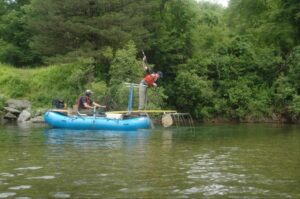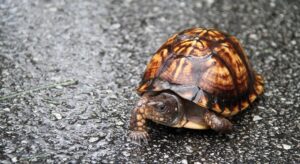The Swift River is one of the most unique and popular trout fishing destinations in Massachusetts. In addition to the wild brook trout found in the Swift, MassWildlife also stocks rainbow and brown trout from its McLaughlin Hatchery. Many anglers travel for miles to fish the cold, clear waters of the Swift in the hopes of landing a big trout. But what exactly happens to the hatchery trout once they are released into the river? This spring, MassWildlife launched a study to get a better understanding of the survival and movement of stocked trout from month to month and from year to year. 
The Swift is bounded by the Quabbin Reservoir’s Winsor Dam to the north and by the Bondsville Dam about 5 ½ miles downstream. So, while some fish enter the reach from Quabbin or from the adjacent McLaughlin Hatchery and some escape over the Bondsville Dam, the study area is a mostly closed system. This means that biologists can estimate population size and learn about fish survival by conducting a series of mark-recapture surveys. MassWildlife biologists will mark every fish stocked into the Swift and then periodically sample the stream and record information on the fish they catch. This type of survey allows biologists to estimate fish populations throughout the year in an area where it is impractical or impossible to count each individual fish.
The fish will be marked in two ways. Biologists will use Visible Implant Elastomer (VIE)—a dye injected just below the skin—to tag trout and indicate the month in which they were stocked. For 2021, all VIE tags will be placed just behind the left eye and different colors will indicate the month the fish was stocked. Additionally, the adipose fins of fish stocked upstream of Route 9 will be clipped; fish stocked elsewhere will not be clipped. The adipose fin is a small fatty fin on the dorsal surface (back) of the fish. MassWildlife staff will use electrofishing equipment to sample the river about once a month for most of the year. This method briefly stuns fish so they can be easily netted, inspected, and then quickly released. By looking at the combination of markings, biologists can learn when and where a trout was stocked in the river compared to when and where it was re-captured.
Anglers will also be able to use the marking to learn about the fish they catch. A website has been launched with details about this ongoing project. Anglers and interested individuals can visit mass.gov/swift-trout to get a list of VIE tag and fin clip combinations that shows release dates and release location. A schedule of electrofishing sampling dates will also be available on the website.
In time, study results will also be posted to mass.gov/swift-trout. Results from this study will provide valuable details about the short- and long-term survival of stocked brown and rainbow trout.
Trout stocking
Last week, subject to last minute change, the following local waters were scheduled to be stocked by Massachusetts DFW: South River in Ashfield, Swift River in Ashfield, Goshen and Cummington, Stones Brook in Goshen, Hoosic River (North Branch) in Clarksburg and North Adams, Green River (North) in Williamstown and New Ashfield, Mill Brook in Cummington and Plainfield, Westfield Brook in Windsor and Cummington, Housatonic River (Southwest Branch) in Pittsfield, Upper Highland Lake in Goshen, Ashfield Pond in Ashfield, Littleville Reservoir in Chester and Huntington, Laurel Lake, Lake Buel, Lake Garfield, Otis Reservoir, Onota Lake, Richmond Pond and Stockbridge Bowl.
Heritage Hub
MassWildlife recently launched a new online portal called “Heritage Hub” which allows users to report observations of animals and plants, natural communities, and vernal pools. The system can be used to report any species and they are especially interested in reports of animals and plants listed under the Massachusetts Endangered Species Act. The Heritage Hub is replacing the Vernal Pool & Rare Species Reporting System (VPRS) and makes electronic reporting easier than ever. MassWildlife is grateful for the many citizen scientists, consultants, and researchers who have contributed 21,537 observations to VPRS over the years and they are looking forward to the launch of the new platform. Visit mass.gov/heritagehub to learn more and register for an account.
The Heritage Hub is a more user-friendly application, improving the functionality from VPRS and offering several new features, including: Updated plant, animal, and vernal pool observation reporting; a natural community form; enhanced user interface via a new mobile-responsive platform; streamlined account creation, electronic signature capture, and many other features. Reports made through Heritage Hub help MassWildlife’s Natural Heritage and Endangered Species Program protect rare animals and plants across Massachusetts. The Heritage Hub was built in collaboration with the Office of Energy & Environmental Affairs IT Department.
Drivers: Watch out for turtles
The following is a message from MassWildlife: From mid-May to early July, thousands of turtles throughout Massachusetts travel to new areas to find food and nest. You may find turtles on roadways, in your backyard, or other unexpected locations as they move across the landscape to find resources they need to survive. Turtles have a keen sense of direction and may be on their way to wetlands or open, upland sites such as lawns, gravel pits, or roadsides for nesting. If you find a turtle, do not move it far away.
“Adult turtles can live past 80 years. Young turtles and eggs, on the other hand, have a variety of predators and a low chance of reaching adulthood,” says Dr. Mike Jones, MassWildlife State Herpetologist. “This is why it’s especially important to protect older adult turtles from cars, especially during this time of year when turtles are crossing roads more frequently.” Losing any adult turtles, particularly adult females, is a serious problem that can lead to the eventual local extinction of a population.
Be safe. Do not risk getting hurt or causing harm to others by unsafely pulling off the road or trying to dodge traffic. If the opportunity to safely move a turtle from the road occurs, move it in the direction it was heading and off the edge of the road. The turtle is trying to get to habitats and resources it needs and knows. Do not take turtles home or move them to a “better” location; turtles should not be moved more than 100 yards from where they are found. Most turtles should be grasped gently along the shell edge near the mid-point of the body. However, snapping turtles are fast and have very powerful jaws that can inflict a bad bite. A snapping turtle can reach your hands if you lift it by the sides of its shell. If you must move a snapping turtle, use a broom to coax it into a plastic tub or box. Never lift a snapping turtle only by the tail; this can injure its spine.
Slow down. Watch for turtles on roadways bordered by wetlands on both sides. These areas are commonly used as crossing points. Also, remember areas where you’ve seen turtles crossing in the past. Turtles are animals of repetition and chances are, more turtles will likely cross there or somewhere close by.
Report them to MassWildlife. Information that you provide on the Linking Landscapes online portal helps MassWildlife and MassDOT prioritize transportation projects to help turtles and other wildlife safely cross roads and keep drivers safe. Just as importantly, contact your town Conservation Commission and local conservation partners to evaluate resources within your town to help turtles. Signage, barrier fencing, or seasonal speed bumps help reduce roadkill.
Massachusetts is home to ten native species of terrestrial and aquatic turtles. Six of the ten species are protected under the Massachusetts Endangered Species Act. Learn more in MassWildlife’s Guide to Turtles of Massachusetts.
Fishing Derby
The Berkshire Hatchery Foundation in Hartsville-New Marlborough is scheduled to have a youth fishing derby next Saturday, May 8 from 9:00 to 10:30 am at its Lower Pond at the Berkshire National Fish Hatchery, 240 Hatchery Road, Hartsville, MA. Children aged 13 and under must be accompanied by an adult. These fishing derbies will run once a month through September. Following State guidelines, masks are required as is 6 feet social distancing.
